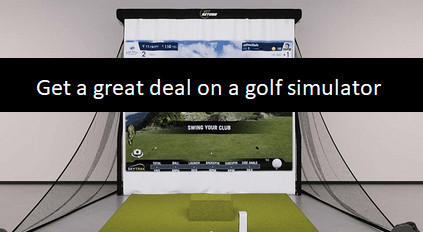Golf Simulator Metrics: What is Launch Angle?Golf simulators have revolutionized the way golfers practice and analyze their game. These advanced technologies provide valuable insights into various golf swing metrics that can significantly impact a golfer's performance. One such metric is launch angle, a crucial factor in determining the trajectory and distance of a golf shot. In this comprehensive guide, we will explore the science behind launch angles in golf simulators, its impact on carry distance, and how golfers can optimize their launch angles to achieve optimal ball flight. 1. Introduction to Launch AngleLaunch angle refers to the angle at which the golf ball takes off from the clubface in relation to the ground. It plays a crucial role in determining the initial trajectory and eventual distance the ball will cover. In simple terms, a higher launch angle results in a higher ball flight and increased carry distance, while a lower launch angle produces a flatter trajectory with less carry. Understanding and optimizing launch angles can make a significant difference in a golfer's overall game. 2. The Relationship between Launch Angle and DistanceWhen it comes to maximizing carry distance, launch angle is just as important as swing speed. While swing speed directly affects ball velocity, launch angle determines the ball's trajectory and the amount of time it spends in the air. The combination of these factors ultimately determines the distance the ball will travel. Golfers who consistently achieve optimal launch angles can achieve longer carry distances due to an optimal balance between height and forward momentum. This balance allows the ball to remain in the air for a longer duration, reducing the impact of gravity and maximizing the potential distance covered. 3. Factors Influencing Launch AngleSeveral factors contribute to the launch angle of a golf shot. Understanding these factors can help golfers optimize their launch angles for improved performance. a. Swing Speed and Launch AngleSwing speed, the velocity at which the clubhead travels through impact, is a critical determinant of launch angle. Generally, higher swing speeds tend to generate lower launch angles due to the increased compression of the ball at impact. Conversely, golfers with slower swing speeds may benefit from higher launch angles to maximize carry distance. b. Loft and Launch AngleThe loft of the club also plays a significant role in determining launch angles. Lower lofted clubs, such as drivers with less loft, tend to produce lower launch angles. Conversely, clubs with higher lofts, such as fairway woods and irons, generate higher launch angles. Understanding the optimal loft for each club is essential for achieving desired launch angles. c. Angle of Attack and Launch AngleThe angle of attack refers to the direction in which the clubhead approaches the ball during impact. A steeper angle of attack, where the clubhead is descending sharply, tends to result in lower launch angles. Conversely, a shallower angle of attack, where the clubhead is ascending through impact, leads to higher launch angles. Golfers can manipulate their angle of attack through adjustments in their setup and swing mechanics to optimize launch angles. 4. Ideal Launch Angles for Different ClubsThe ideal launch angle varies depending on the club being used. While there is no one-size-fits-all launch angle, understanding the general guidelines can help golfers achieve optimal ball flight.
a. DriverFor the driver, the average launch angle on the PGA Tour is around 10.9 degrees, while the LPGA Tour averages around 13.2 degrees. These launch angles provide a balance between distance and control, allowing the ball to carry a significant distance while still maintaining control. b. Fairway Woods and HybridsFairway woods and hybrids generally require slightly lower launch angles compared to the driver. The average launch angles for these clubs on the PGA Tour are approximately 9.2 degrees for 3-woods and 9.4 degrees for 5-woods. LPGA Tour averages are slightly higher at 11.2 degrees for 3-woods and 12.1 degrees for 5-woods. c. IronsAs the loft of the clubs increases, so do the optimal launch angles. For example, the average launch angle for a 6-iron on the PGA Tour is around 14.1 degrees, while on the LPGA Tour, it is approximately 17.1 degrees. This trend continues as the loft increases, with higher launch angles for higher lofted clubs. 5. Importance of Launch Angle OptimizationOptimizing launch angles is crucial for golfers looking to maximize their carry distance and overall performance. By achieving the ideal launch angle for each club, golfers can achieve optimal ball flight, consistent carry distances, and improved accuracy. Launch angle optimization also helps golfers overcome common challenges, such as excessive spin rates or inconsistent ball flight. By fine-tuning launch angles, golfers can reduce spin rates, resulting in longer distances and better control. 6. Using Golf Simulators to Analyze Launch AnglesGolf simulators provide an excellent platform for analyzing launch angles and their impact on performance. These advanced technologies capture and analyze swing data, including launch angle, ball speed, and spin rates. By using golf simulators, golfers can gain valuable insights into their launch angles, identify areas for improvement, and track progress over time. 7. Strategies to Improve Launch AnglesImproving launch angles requires a combination of proper technique, equipment selection, and practice. Here are some strategies to help golfers optimize their launch angles: a. Adjusting Ball Position and StanceBall position and stance play critical roles in achieving optimal launch angles. For drivers, positioning the ball towards the front of the stance and tilting the lead shoulder slightly higher than the back shoulder can help golfers launch the ball higher. Conversely, using a more centered ball position and a flatter shoulder alignment can lower launch angles for fairway woods and irons. b. Swing Path and Clubface AlignmentThe swing path and clubface alignment also influence launch angles. Golfers can manipulate their swing paths to promote either an upward or downward attack angle, affecting launch angles accordingly. Similarly, adjusting the clubface angle at impact can help fine-tune the launch angle. Experimenting with these variables during practice sessions can lead to significant improvements in launch angles. c. Equipment Selection and FittingChoosing the right equipment and ensuring proper fitting is essential for optimizing launch angles. Golfers should consider factors such as club loft, shaft flex, and clubhead design to achieve their desired launch angles. Consulting with a professional club fitter can provide valuable insights and recommendations tailored to individual swing characteristics and launch angle goals. 8. Common Mistakes and How to Correct ThemWhile working to optimize launch angles, golfers may encounter common mistakes that hinder progress. These include poor contact, improper swing mechanics, and inconsistent setup. By addressing these issues through proper instruction, practice, and feedback from golf simulators, golfers can correct these mistakes and improve their launch angles. 9. The Role of Spin Rate in Launch Angle OptimizationSpin rate, the rate at which the ball rotates in flight, is closely related to launch angles. Golfers should strive to achieve an optimal balance between launch angle and spin rate to maximize distance and accuracy. High spin rates can lead to excessive backspin, reducing carry distance. By working with launch monitors and golf simulators, golfers can adjust their launch angles to achieve an optimal spin rate for their desired ball flight. 10. Trackman and Other Golf Simulator TechnologiesTrackman is one of the most renowned golf simulator technologies used by professionals and amateurs alike. With its advanced tracking capabilities, Trackman provides accurate launch angle measurements, along with other key metrics such as ball speed, spin rates, and clubhead path. Other golf simulator technologies, such as Foresight and Full Swing, offer similar capabilities, providing golfers with valuable insights into their launch angles and overall performance. 11. Real-World Examples and Expert OpinionsReal-world examples from professional golfers and insights from industry experts can further enhance our understanding of launch angles. These examples demonstrate how launch angles vary across different clubs and provide valuable benchmarks for golfers looking to optimize their own launch angles. Additionally, expert opinions from professionals in the golf industry offer valuable insights and strategies for launch angle optimization. 12. ConclusionOptimizing launch angles is a key factor in maximizing carry distance and overall performance in golf. By understanding the relationship between launch angles, swing speed, loft, and other variables, golfers can make informed decisions to achieve optimal ball flight. Utilizing golf simulators and technologies like Trackman can provide valuable feedback and help golfers fine-tune their launch angles for improved distance, accuracy, and consistency. With practice, patience, and a focus on launch angle optimization, golfers can unlock the full potential of their game.
0 Comments
Your comment will be posted after it is approved.
Leave a Reply. |
|




 RSS Feed
RSS Feed


